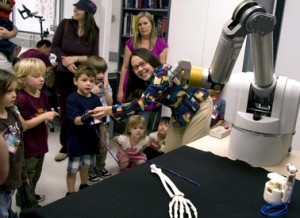
Kids try their hands at robotics technology
Posted: April 21, 2010

ASU assistant engineering professor Veronica Santos (at right) instructs preschool students how to use a sensor glove to control the fingers on a robot hand at the Biomechatronics Lab. (Photo: Jessica Slater/ASU)
Youngsters recently got some interactive experience with advanced robotics technology at Arizona State University’s Biomechatronics Lab.
The group from ASU’s Mary Lou Fulton College of Education Preschool was given a tour and hands-on demonstration by the lab’s director, Veronica J. Santos, an assistant professor of mechanical engineering in ASU’s Ira A. Fulton Schools of Engineering.
The preschoolers used a glove equipped with sensors that track the motions of the glove wearer’s index, middle and ring fingers, which make the three fingers of the robot hand perform the same movements.
They made the robot hand point at fellow classmates, clench its fingers into a fist, and even make a “peace sign.”
Santos and fellow researchers work with the robot hand and similar devices to develop human-machine systems. Such systems enable disabled or injured people to expand their range of movement. They also are used as tools to explore space, the depths of the oceans and other environments where it is difficult or dangerous for humans to go.
The research produces control systems for prosthetic hands that improve the independence of amputees, and for wheelchair-mounted robot hands for increasing the abilities of wheelchair-bound individuals.
Beyond basic robotics, the work requires expertise in such areas of engineering as neuromuscular biomechanics, tactile sensor technology, and the control and sensory aspects of human-machine systems.
Besides lab tours for younger students, the Biomechatronics Lab researchers have demonstrated their work at the Arizona Science Center and the recent ASU Brain Fair.
The lab also provides opportunities for ASU graduate and undergraduate students to engage in research. Several students are involved in ongoing projects in the lab.
It was undergraduate bioengineering major Ben Teplitzky who came up with the idea of developing the sensor-equipped glove to control the robot hand, Santos said.
For more information, see the Biomechatronics Lab website.



































